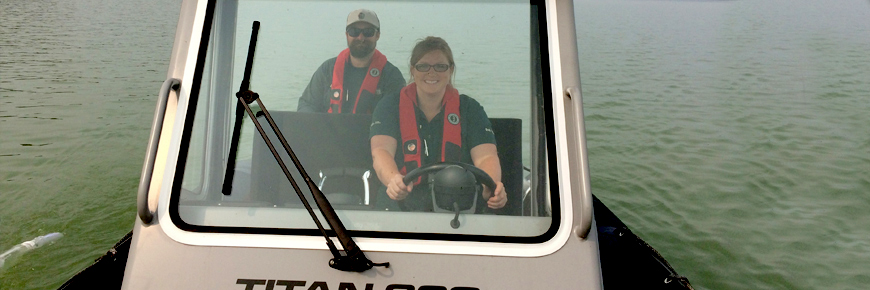
Nurdles in a haystack
Lake Superior National Marine Conservation Area
by Margaret (Peggy) Ireland
Parks Canada’s Resource Conservation staff at Lake Superior National Marine Conservation Area (NMCA) trawl the world’s largest fresh water lake for traces of microplastic pollution.
Summer was starting to turn to fall as Resource Conservation Manager Lisa Nyman captained Lake Superior NMCA’s new boat The Coaster, holding the 22-foot rigid-hull inflatable steady while ecologist Doug Tate deployed a trawl specially designed to capture tiny particles floating near the water’s surface. This was just the start of the Resource Conservation team’s ongoing monitoring program.
Over the coming years Parks Canada’s ecologists will make a number of water trawls in various parts of the marine conservation area in order to develop a baseline of how much microplastic pollution can be found in this part of Lake Superior. A 2016 report on microplastics in the Great Lakes identified a great deal of plastic pollution in the lower Great Lakes, but researchers admitted that significant knowledge gaps still exist in various regions, and in Lake Superior in particular.
Scientists are concerned because once microplastics (5mm or less in size) enter the Great Lakes they can be very difficult, or impossible, to remove. In addition to chemicals added when plastics are manufactured, they can also absorb persistent organic pollutants (POPs) that exist in the water. Because of the minute size of the small particles, they can be ingested by fish throughout the lakes, the fish then become contaminated by these chemicals.
Most microplastics in the Great Lakes come from broken down pieces of discarded plastic trash, or accidental dumping. Waste water treatment plants surrounding the lakes are a common source of the smallest particles. They come from cleaning products that people wash down their drains, including the beads in many toothpastes and facial cleansers, and small fibers from synthetic clothing such as fleece pullovers which break off as they are washed.
This summer, floating nurdles (little pellets used to manufacture plastic products) were captured by the team during a plastics trawl in an area south of Fluor Island. Separately, a group of local volunteers and Parks Canada staff participating in a shoreline clean-up at Mountain Bay Beach collected an estimated 198,000 nurdles. Interpretation Officer Sarah Shruiff sent a sample of these Lake Superior nurdles to a researcher in Japan who is part of the International Pellet Watch, a volunteer-based global monitoring program designed to monitor the pollution status of oceans and other waters.
The work to monitor plastic contaminants in Lake Superior NMCA is part of Parks Canada’s mandate to act as guardians of our national parks and national marine conservation areas, ensuring Lake Superior is used in an ecologically sustainable way and preserved for future generations.
- Date modified :